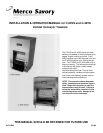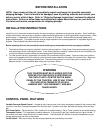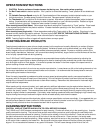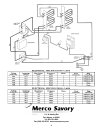3
OPERATION INSTRUCTIONS
1. CAUTION: Exterior surfaces of toaster become hot during use. Use caution when operating.
2. Set Bun/Toast switch to desired position. “Bun” position for one sided toasting; “Toast” position for two-sided toast-
ing.
3. Set Variable Conveyor Speed control to #8. Experimentation will be necessary to obtain desired results on your
individual products. Increase speed if product is too dark. Decrease speed if product is too light.
4. Set Thermostat at #7 and allow a 20 minute warm-up period. After warm-up period has elapsed, adjust to desired
setting. Experimentation will be necessary to obtain desired results on your individual products. Rotate to a higher
number if product is too light. Rotate to a lower number if product is too dark.
When toasting bread (Both sides): Follow steps listed above setting Bun/Toast switch to “Toast” position. Place bread
in the exposed carriers behind the product retainers. If toaster has been operating in the “Bun” position, allow a few
minutes for heat build-up.
When toasting buns (single side): Follow steps above setting Bun/Toast switch to “Bun” position. Place buns in the
exposed carriers, behind the product retainers. Be sure to place CUT SIDE OF THE BUN FACING OUTWARD. If toaster
has been operating in the “Toast” position, allow a few minutes for heat-escape time.
NOTE: Toasting English muffins or bagels will require slower conveyor speed.
TOASTING BREAD PRODUCTS
Toasting bread products may seen to be a simple process, but the results can be easily affected by a number of factors.
The first consideration is the type of product being tested. Varieties of bread, such as whole wheat, rye, white, English
muffins, bagels and buns have different requirements to become perfectly toasted. Dryness or moisture content of the
bread (mostly described as “freshness”, with more moisture being the fresher), sugar content and the thickness of the slice
or bun all play a predominate role during toasting.
Your C-20VS and C-40VS toasters are designed to accommodate these varieties of bread products by adjusting the
conveyor speed to create lighter or darker toasting and to allow for toasting thicker products that contain more moisture
such as English muffins or fresh bagels. It is normal to operate the toaster in the lower ranges of the speed control to
perform toasting of these more difficult products.
Certain breads that contain fruit and nuts may require more attention. Loose pieces can fall on the heating elements or into
the conveyor mechanism and cause premature wear on the toaster. It is recommended that loose pieces be removed
before placing the bread on the conveyor.
Since it is nearly impossible to predetermine what conveyor speed produces perfect results, some experimentation is
necessary with all the types of bread you will be toasting. Once all varieties of product have been tried and the proper
settings found, document the results and refer to them when toasting. Remember that allowances for freshness might
require additional adjustments.
When toasting a high volume of product, as in peak periods, additional adjustment may be required when demand is
reduced to an occasional toast order. If the toaster is operating, without bread passing through the conveyor, heat builds
up within the “empty” toaster. The occasional toast order now will brown more rapidly and may require turning conveyor
speed to a higher number to compensate. Conversely, when toasting occasional orders and changing to high volume may
require slowing the conveyor because the higher volume of bread actually cools down the toaster.
When going through these transitional periods, adjust conveyor speed faster or slower accordingly. It is suggested that you
set the conveyor speed at a lower number for thicker products or when the toaster is cool and to a higher number when
toasting thinner products or when the toaster has been idle for a period of time.
CLEANING INSTRUCTIONS
CAUTION: UNPLUG TOASTER AND ALLOW TO COOL BEFORE CLEANING.
The C-20VS and C-40VS toasters are designed for easy cleaning. Crumbs will collect only in the receiving tray. It can be
readily removed for cleaning. The lustrous outer surface need nothing more than a daily wiping with a soft damp cloth.
Product carriers must be removed for cleaning. Position carrier midway in front of the machine. Press one carrier chain to
the side to allow carrier chain pins to slip out of the holes in the side of the carrier. Clean carriers in hot sudsy water.
Straighten any bent wires before replacing. When replacing, start the first carrier on the pins directly under the blank space
on the carrier chain created by the master link. Be sure pins enter the proper holes and that the carriers are properly
aligned. Do not use abrasive cleaners on any part of this toaster. This will cause damage to the finish of the unit.






